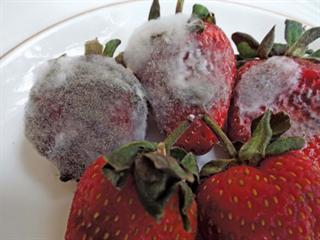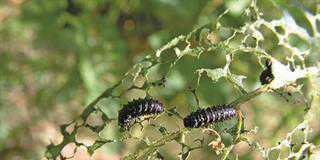
There are more than 30 species of the fungal disease grey mould (Botrytis sp). The most common is B cinerea. In wine-growing, grey mould is known as ‘noble rot’ and can cause severe economic loss. Botrytis can hit a plant at any time of the year, although it tends to be more prevalent during the cooler months. Almost every plant species, be it annual, perennial, herbaceous or ornamental, as well as soft fruit such as strawberries, grapes and tomatoes, are at risk.
This fungal infection is not only prevalent in living plants, but can be found in stored and transported fruit and vegetables. Botrytis is a ‘saprophyte’ – an organism that flourishes on dead organic material. The fungal spores are ever-present in the air. They normally attack plants or fruit that are stressed, but may also infect healthy plants kept in less than optimum conditions – overwatered or exposed to the cold, for example.
Botrytis is also a common problem where plants are grown under glass and subjected to high humidity, and overcrowding. In some situations, Botrytis can be latent, infecting the plant but developing no symptoms until a specific time in the plant’s life-cycle, such as when the fruit ripens. As the sugars in the fruit are at their greatest level at this time, the slightest damage, or even an attack by a pest, can trigger the fungus’s appearance.
Generally, the first indication that a plant is infected is when the area in question turns brown and begins to rot. This rot then develops a grey, fluffy mould. Where the plant is kept in unusually high humidity, or is regularly over-watered and the soil is continually sodden, the rotting and mould will spread rapidly and eventually envelop the entire plant or fruit.
It spreads in two ways. First, it can lie dormant in dead tissue until a suitable host is found. Second, the fuzzy fungal growth releases asexual spores into the air which then float around until finding a suitable host. These spores appear as dust if the mould is touched.
Treatment
The earlier the detection, the more positive the Botrytisoutcome. Although there are a number of commercial fungicides available to treat this fungus, most show moderate to high levels for potential resistance. It is therefore important to rotate fungicides even if they are used only occasionally.
As the fungus thrives in cool, damp, poorly ventilated environments, greenhouse plants are particularly at risk. To prevent Botrytis, ensure there is good air movement around the plants, reduce watering, avoid overcrowding and ensure good soil drainage. Try to create a slightly drier environment, and avoid condensation.
If you are growing vegetables, fruit or flowers that are susceptible to this fungus, don’t plant them too closely together. Promote good soil drainage and avoid overhead watering. Maintain a weed-free base around the plant to limit the spread of the fungus.
Remove dead or dying leaves and flowers, and do not leave rotting plant matter around the base of the plant. When all else fails, the infected part of the plant should be removed and burnt. Do not use this sections as compost, as this might infect other plants with Botrytis. Finally, ventilate the greenhouse to dry out the damp, stagnant air.












